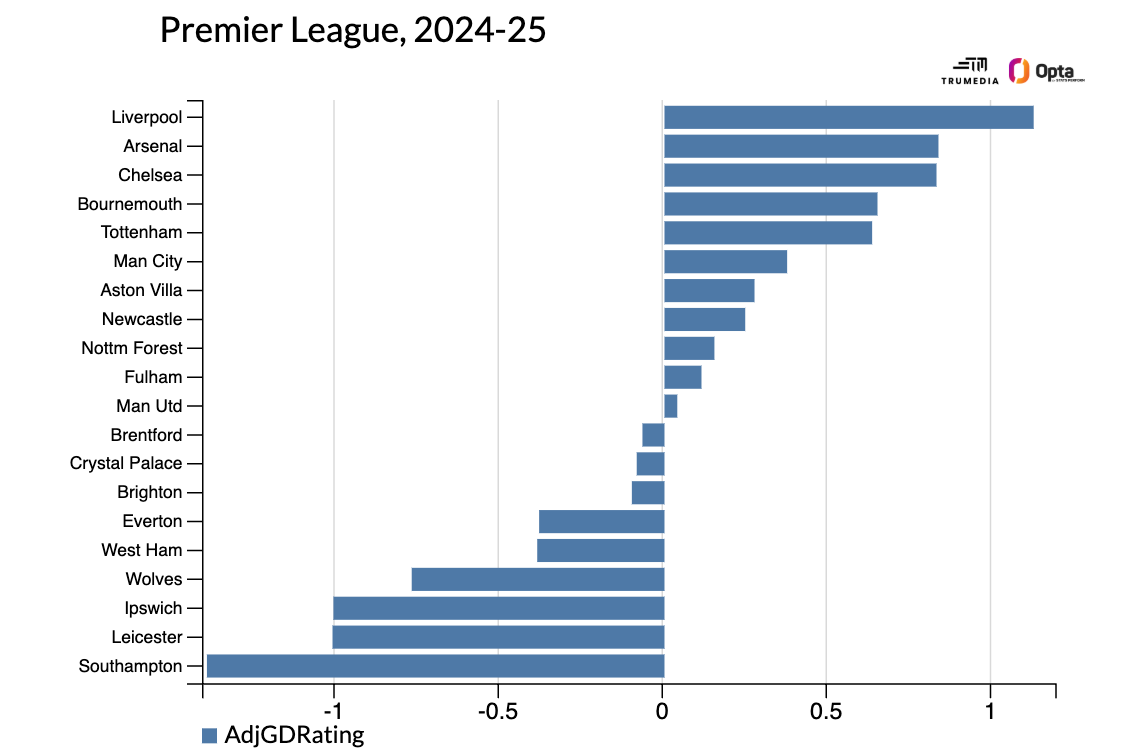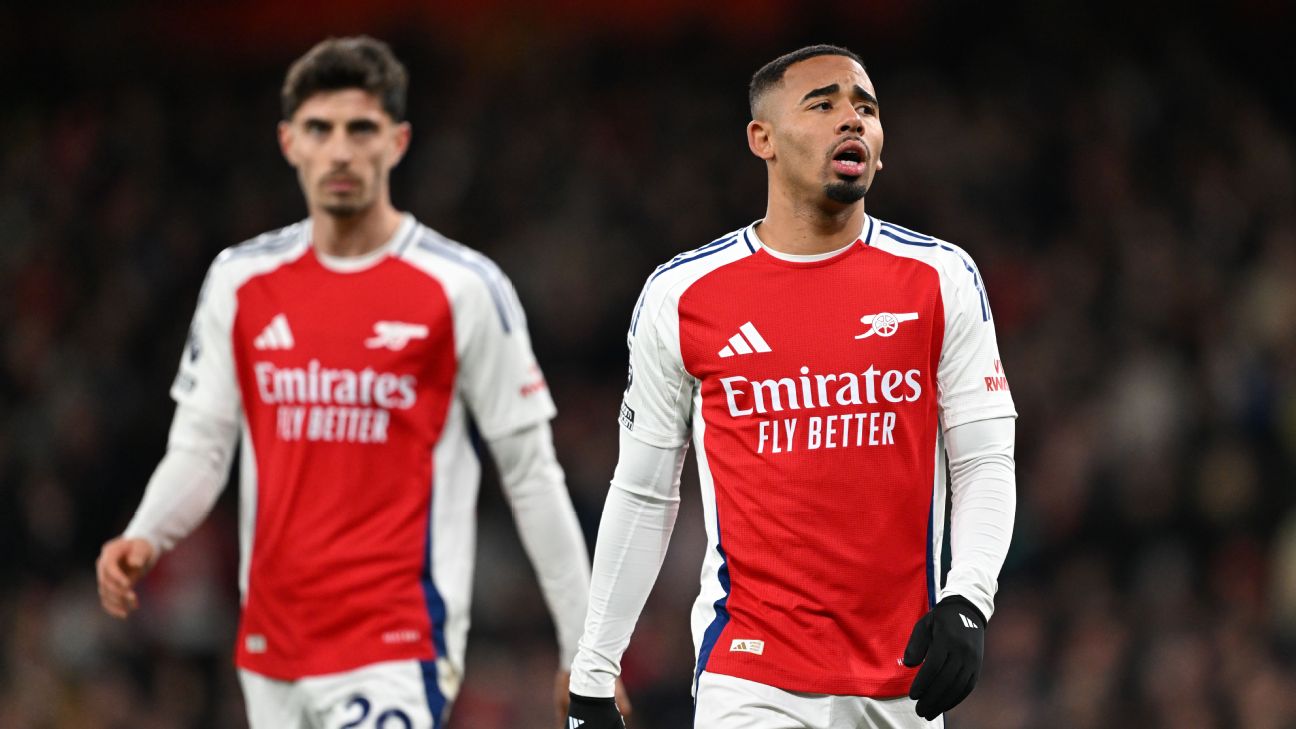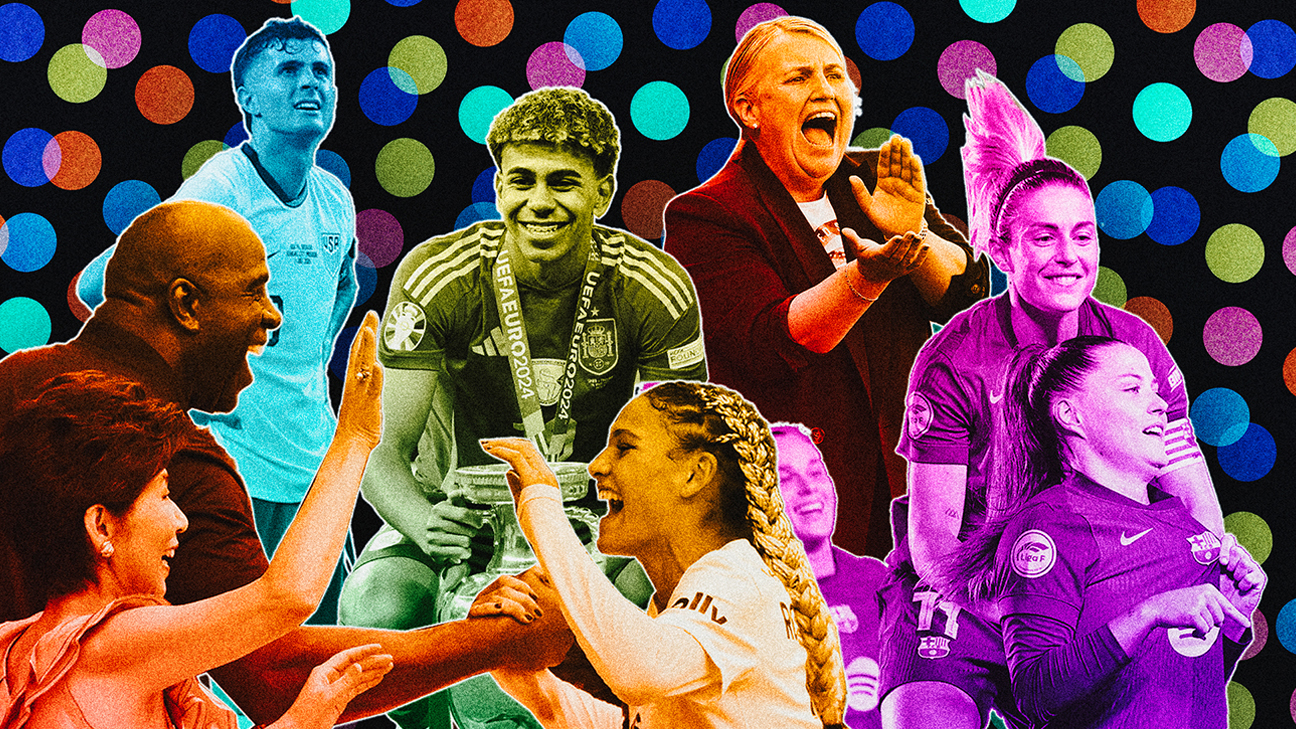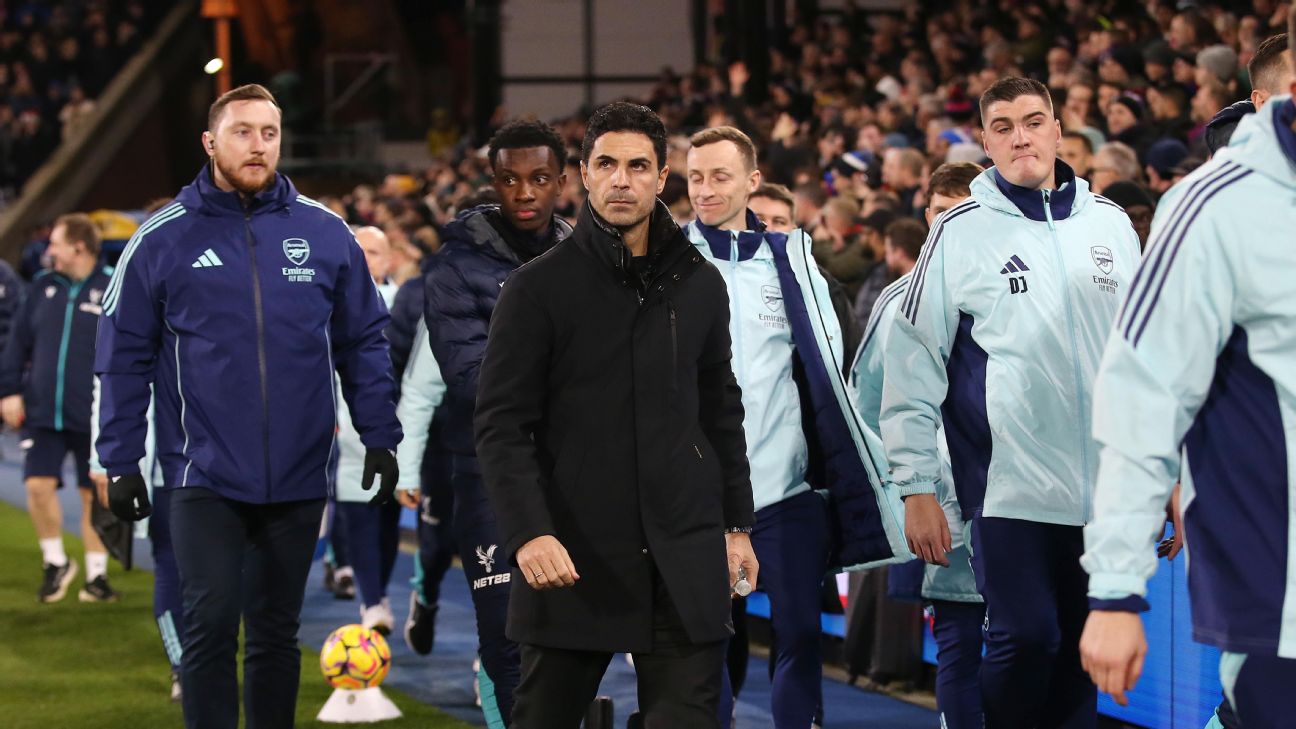Let’s say that, somehow, before the 2024-25 season, I was able to tell you two things:
1. Rodri would get injured, and Manchester City’s aging and tiny squad would finally implode in on itself
2. One other team would emerge as the clear favorite to win the league before we’d even hit the halfway point.
What would you have done? Some of you might have booked a flight or train to London for May. Others, perhaps, would have placed a sizable wager on the team that finished second in the Premier League in each of the past two seasons to finally get over the hump and win their first league title since they went undefeated in 2003-04.
After back-to-back campaigns of pushing City deep into the spring, Arsenal entered the season as that rare kind of multiyear title contender that was only supposed to get better. Rather than maxing out a couple of years with a squad of peak-age players, the average age of Mikel Arteta’s squad last season (25.0) was the third youngest in the league.
Yet, while City have collapsed and an odds-on title favorite has emerged, it’s not Arsenal. Instead, they’re six points back of Liverpool, who still have a game in hand. On a points-per-game basis, the Gunners are closer to ninth than to the top of the table.
Just 16 games in, it’s already feeling like it might be a lost Premier League season in North London. So what’s behind Arsenal’s struggles? Let us rank the reasons.
1. The bounces have stopped going their way
I mean this in a number of different ways, but I think it makes sense to group it all together. I don’t think “luck” is the precisely right word, but I’m talking about the things in the sport that tend to happen somewhat randomly and aren’t necessarily predictive of themselves.
All of that stuff? It went Arsenal’s way in each of the past two seasons, and it’s going the other way so far this season.
We’ll start here, with the number of red cards suffered by the 17 ever-present Premier League teams from the previous two seasons:

Before those two years, Arsenal under Arteta had developed a reputation as being one of the least disciplined teams in the league. In the 2021-22 season, a number of high-profile red cards — against Man City and Tottenham, in particular — destroyed their chances of winning matches against teams that finished higher than them in the table. All of a sudden, though, the sendings-off disappeared over the past two seasons.
Was this evidence of the improved culture cultivated by Arteta and the emotional stability of the new players acquired from the summer of 2022? Or was it mostly just random noise and good fortune? The numbers from this season suggest the latter:

Just as it was unlikely that they’d continue to receive only a single red card per season, it’s equally unlikely that Arsenal would continue to get a player sent off every fifth or sixth match. But the red cards have already had an effect. In two matches, they blew leads and drew games that they were winning before going down a man. And in another, they simply lost.
On top of that, Arsenal were able to rely on a super-heavy minutes load from a core in each of the past two seasons. In 2022-23, Gabriel (99.7%), Bukayo Saka (93.0 %), Martin Odegaard (91.4%), Ben White (89.3%) and William Saliba (70.6%) all played at least 70% of the minutes. The only one who missed a significant amount of time was Saliba, and that pretty much directly coincided with their collapse down the stretch.
Last season, Saliba didn’t miss a single minute, while the other four all played similar amounts: Odegaard (90.4%), Gabriel (89.0%), White (87.4%), and Saka (85.4%). Declan Rice was signed for over $100 million last summer and immediately became part of that group too, featuring in 94.3% of the available minutes. They were better last year than the year before in large part because Saliba stayed healthy and Rice hit the ground running.
This season, though, everyone other than Saka (86.5%) has played a little less often. Saliba is down to 89.5% because of the red card against Bournemouth. Gabriel is down to 81.8% because of a handful of injuries, while Rice has featured in 80.8% of the minutes after his own red card and some injury issues. Odegaard, meanwhile, has missed half of the season (50.4%) with a foot injury, and White (48.4%) had knee surgery a month ago.
Lop off that many minutes from your core talent and increase your red card rate by more than, uh, 700%, and I think we can get pretty much all the way there in explaining why Arsenal won 89 points last season and are currently on pace for 71 this year.
If Arsenal continue to get this many red cards and continue to get this few minutes from their stars, then yeah: they’re nowhere near title contention.
2. Their signings haven’t moved the needle
Of course, it’s not just injuries and red cards — especially since injuries and red cards are a part of the game. To constantly give yourself a shot at winning the league, you have to be able to overcome the inevitable injuries and penalizing referee decisions that Arsenal haven’t really had to deal with over the previous two seasons.
Mikel Arteta defends Arsenal’s record of scoring from open play after their goalless draw vs. Everton.
If we go back and look at that core of players, almost all of them have been with the team since before Arsenal, for lack of a better term, got good. Saka is a youth product, while White and Odegaard joined in 2021, Gabriel in 2020, and Saliba in 2019 (even though he went out on loan until two seasons ago.) Outside of Rice, I’d argue that everyone else they’ve signed over the past two seasons have been for depth — players who have raised Arsenal’s floor, but not their ceiling.
Kai Havertz makes almost every team he plays for better in mostly invisible ways, but he’s rarely going to decide a game on his own. Jurriën Timber is a reliable, flexible defender, but White provided about 0.16 of expected-possession value per game last season. In other words, per Opta, that’s how much all of his on-ball actions contributed to Arsenal’s likelihood of scoring a goal each game. This season, Timber is all the way down at 0.06.
On the other side of the back line, Riccardo Calafiori fits a similar mold, but he’s been hurt and hasn’t made a huge difference when healthy, either. Mikel Merino, this summer’s other permanent acquisition with Calafiori, has also struggled to stay healthy and for a fee of around $42 million, he wasn’t expected to be a star anyway.
Even going back to the players signed during the 2022-23 title race: Jorginho was already 30 when Arsenal brought him in, while Leandro Trossard was 28, which seems young but is really right around when most players start to decline. Oh, and I forgot about Raheem Sterling — and you probably did, too. Like Trossard, he just turned 30. The Chelsea loanee has only played 148 league minutes.
These are all players who can provide valuable minutes as secondary or tertiary contributors, but they’re not going to turn your highest-possible gear into a higher gear, and you can’t really lean on any of them to pick up the slack when the stars are out. We’ve seen that play out this season, but we’ve also seen how they’ve raised up the club’s worst-case outcomes, too.
Even with everything that’s gone wrong so far this season, the club are still on pace for more points than they won in 2021-22 — the last season before all of them were signed.
3. The attack isn’t good enough
You know how good Arsenal are at set pieces. If not, here you go:

Since the start of last season, they’ve scored 40 goals from set pieces — nine more than any other team. And while I’m not sure they’re that much better in these situations than everyone else, they’re also creating better opportunities than everyone else, in addition to converting them. I’ve been writing about the untapped importance of set pieces for ESPN for nearly a half-decade; Arsenal are what it looks like when you take those words to heart. Arteta — and everyone else at the club — deserve a ton of credit for committing to this approach.
But at what cost?
Maybe Arsenal have been more conservative in the transfer market because they know they can score from set pieces? Are they more conservative in open play because they know they can score from set pieces? Are they so committed to set pieces because they don’t believe in their ability to create from open play? Or do they spend so much time practicing set pieces that it has actually hindered their ability to play in normal possession?
I don’t think it’s the latter; one of the biggest reasons set plays are so valuable is that they don’t require a ton of training time, but can lead to a very real increase in goal scoring. But whatever the exact reason, Arsenal are essentially just a league-average team when it comes to scoring and creating chances from open play:

It’s not any better when we control for all the minutes they’ve played a man down, either. In fact, it’s slightly worse when we only look at minutes at even strength.
They have scored 1.13 open-play goals per 90 minutes when they have the same number of players on the field as the other team, and their underlying numbers are slightly worse than that. Since 2009, the most points won by a team scoring fewer than 1.15 open-play goals per 90 minutes was the 71 earned by Manchester City (0.97) in 2010-11. Or, the exact same pace Arsenal are currently on.
While I do think that Arteta has some conservative tendencies as a manager — see: the gigantic, defensively sound roster he’s built — I’m not sure how much of the blame he should get here. At least, not Arteta the coach. However, some of the signings, which Arteta has played an outsize role in identifying, have certainly played a role in the kind of limited attacking team Arsenal have become.
The only Arsenal players who are truly scary with the ball at their feet are Saka and Odegaard. Havertz just doesn’t score much for a centre-forward, and much of his value comes from what he does off the ball. Trossard has lost a step, Gabriel Jesus has been inconsistent and constantly injured, Sterling never plays, and Gabriel Martinelli hasn’t developed.
At one point, I thought Martinelli might be a better prospect than Saka, but in his age-23 season, the Brazilian is averaging fewer than two shots per 90 minutes this season. Nearly 80 other players in the Premier League are taking more shots than he is this season. You just can’t win enough points to win the league when one of your starting forwards is doing that.

Other than Odegaard, the deeper players don’t provide a ton of attacking threat, either. The new full-backs are all converted centre-backs who help aid buildup play, but don’t do much in the attacking third. And in the midfield, Rice does everything well, but scoring and creating goals is pretty low on the list of responsibilities. Somehow, the third midfielder this year has usually been Thomas Partey, who barely played last season.
If he’s an answer, you’re asking the wrong question.
4. Liverpool (and Chelsea) got hot
Despite the stuttering attack, Arsenal are definitely the best dead-ball team in the world, and arguably the best defensive team in the world, too. They’re allowing fewer than a goal per game, and their xG numbers are even better than that. Per my preferred catch-all metric for predictive team strength — 70% xG, 30% G — they’re the best defense in the Premier League:

Throw in the set pieces, and that bumps them up to sixth by the same metric on the other end of the field. And then throw both of those numbers together to create a differential, and Arsenal rate out as tied with Chelsea as the second-best in the league.

Look only at 11-v-11 minutes — which I don’t love because, among other things, it would actually penalize Liverpool for their impressive 10-man performance against Fulham — and Arsenal are basically dead-even with Liverpool by this metric. The difference is that Liverpool have played fewer minutes down a man, played better when they were down a man, converted more of their dominance into points, and really just haven’t been outplayed once this season.
Chelsea, meanwhile, are undefeated in the league since their mid-October loss to Liverpool: six wins and two draws from their last eight. They’ve only conceded seven goals over that stretch, but that comes from a diet of opponent shots worth 12.19 expected goals. They won’t keep that up for the whole season — Robert Sánchez didn’t suddenly become a great shot-stopper after years of below-average play — but the hot run on defense has been enough to open up a four-point gap on Arsenal and get them within two points of Liverpool — at least, until the league-leaders play their game in hand.
Craig Burley and Alejandro Moreno ponder whether Arsenal are capable of winning their first Champions League trophy this season.
Arsenal’s past two matches in the league — a pair of draws against Fulham and Everton — probably did cost them a real shot at the title. Win both of those, and they’re even with Chelsea. Instead, they created more than three xG across the two games but only scored one goal; on the other end, they conceded 0.25 xG, but still conceded once. While the second half against Everton, at home, was terrible, they still did enough to win both matches. Sometimes the shots just don’t go in.
While I can’t get there with Chelsea just yet, Liverpool have been a fundamentally better team than Arsenal this season — and that, in and of itself, is something of a disappointment for a side that finished significantly ahead of Liverpool in each of the past two seasons. That’s especially true when you add in the departure of Jurgen Klopp and the fact that their only summer signing, Federico Chiesa, has played 19 Premier League minutes.
However, I wouldn’t say that Liverpool have been six-points-plus-a-game-in-hand better, and I wouldn’t be at all surprised if Arsenal won more points-per-game than Liverpool, or any other team in the league, from here on out. In fact, the betting markets expect it; the Sporting Index over-under totals have Liverpool winning 49 more points and Arsenal winning 48 more, in one fewer match.
Unfortunately, that won’t be anywhere near enough points to catch the league leaders. Arsenal, then, could be the best team in the Premier League for more than half of the season — and they still might not come close to finishing first.



